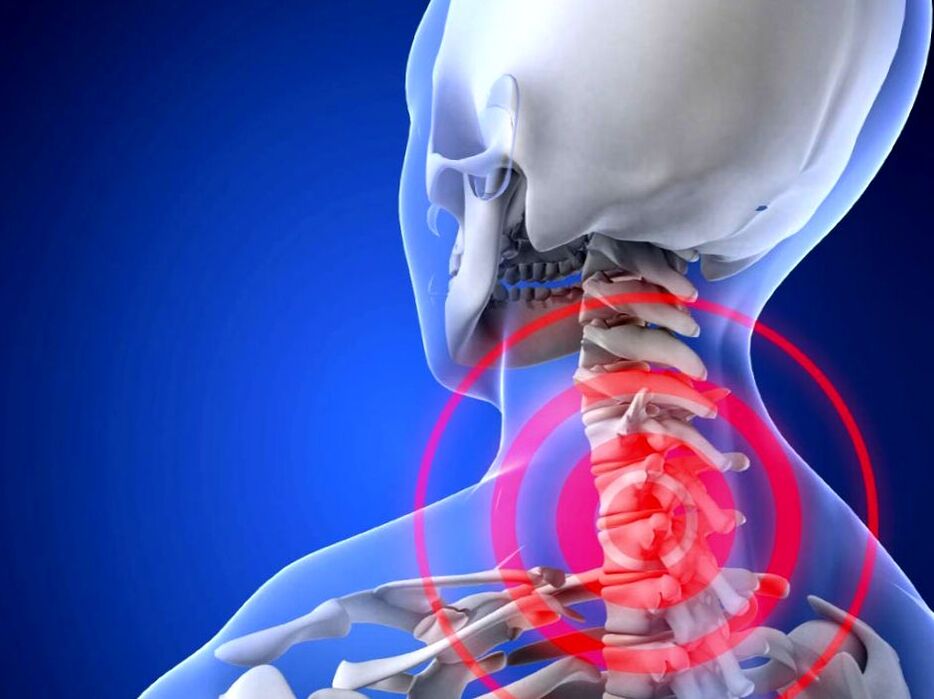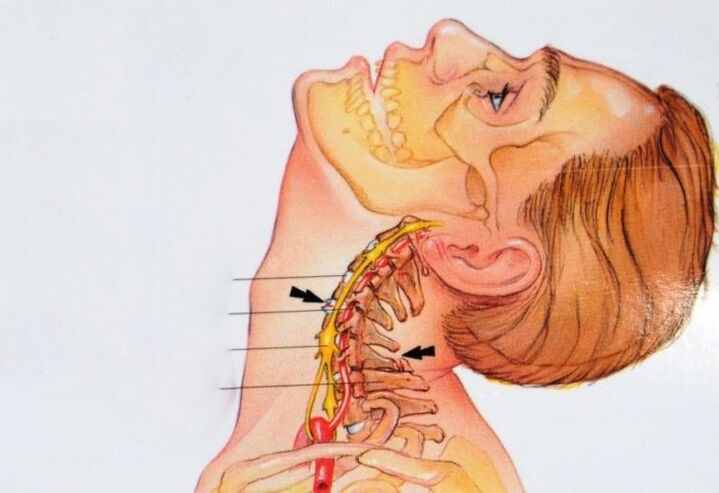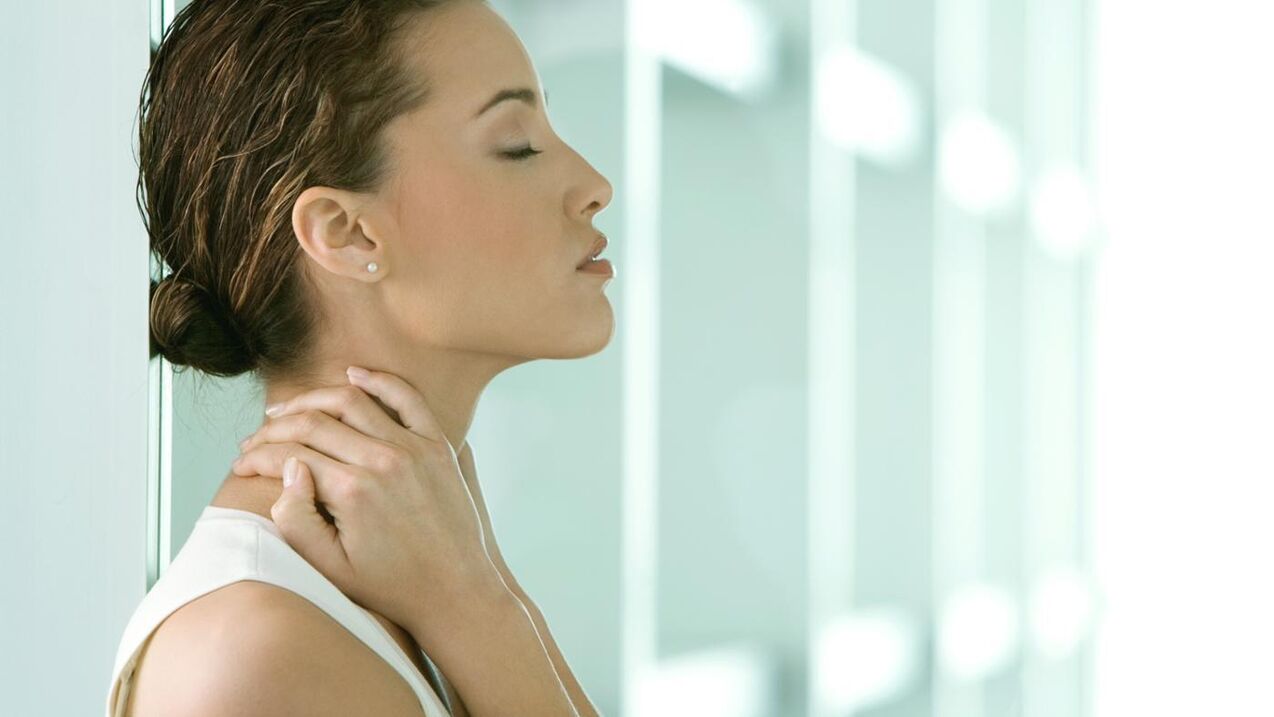Cervical osteosarcoma is a disease characterized by damage to the discs.
Cervical fibroids are one of the most common diseases in the world. According to statistics, about 60% of the world's population faces it, because modern people are sedentary and also spend a large amount of time in sedentary work. Osteochondrosis manifests itself in the form of damage to the disc cartilage, as well as reactive processes in adjacent tissues.
Cervical vertebrae are much smaller than other vertebrae, but the load on them is no less. We are constantly turning our heads, that's why the neck moves systematically. In the early stages, the disease is difficult to recognize, the basic symptoms of the disease are often ignored by the patient. The result is cervical osteonecrosis, which significantly complicates the later treatment.
A modern clinic successfully treats cervical osteosarcoma non-surgically using chiropractic and kinetic therapy.

Causes of cervical osteonecrosis
There are several factors that can contribute to the development of osteonecrosis:
- Inactivity is the main cause leading to the development of a dangerous disease. The complete lack of moderate physical activity leads to deterioration of the muscular and skeletal system. Insufficient daily living is not only a problem of office workers and drivers. People who enjoy spending their free time at the computer or watching TV suffer from arrhythmias.
- Excessive physical activity. Typically, professional athletes who are subjected to axial loads on their backs suffer from this condition. Working within limits also threatens new athletes who train without the supervision of a professional trainer and perform exercises with incorrect technique.
- Negative factors for posture are wearing high heels and uncomfortable shoes, curvature of the spine, flat feet, as well as poor body posture during sleep.
- Excess weight puts a strain on the spine, leading to displacement of the vertebrae and abrasion of the cartilage structure.
- Rheumatism.
- Endocrine system disorders.
- Stress.
- Hypothermia of the neck.
- A sedentary lifestyle (such as drivers and office workers) or excessive physical activity (such as athletes).
As a rule, under the influence of these factors, loads on the cervical vertebrae occur, causing the formation of muscle spasms. As a result, blood circulation is disrupted and metabolism is slower leading to degenerative changes.
An interesting fact: the risk of developing a disease such as osteonecrosis is mainly related to evolutionary changes in the human body. It's about walking upright. During the entire life cycle, the spine performs the "core" function of our body. The vertebrae press on the cartilage discs are worn away, so the connective tissue is degenerated. Therefore, osteonecrosis often feels on its own in old age.
The symptoms and treatment of cervical osteochondrosis will depend largely on what triggered the onset of the disease. To develop an individualized treatment plan, doctors conduct a series of tests. Self-medication is not recommended. Improper massage, medicine or traditional medicine methods can aggravate the situation and lead to a series of irreparable consequences!

Cervical fibroids: symptoms and treatment
The manifestation of a dangerous disease depends on 2 main factors:
- Type of load on the cervical spine.
- Location of damage to the cartilage structure of the disc.
Nerve roots perform a large number of functions, so the symptoms of damage in their individual parts can vary widely. In addition, you need to take into account the stage of development of the disease. There are 4 of them, each next one is heavier than the previous one.
Cervical fibroids 1 degree
This level is called preclinical and is poorly expressed, which is why patients attribute symptoms to stress, sleep deprivation, and other seemingly frivolous problems. The spine begins to defend itself against "destructive" movements and excessive stress, so people begin to feel discomfort.
The main symptoms are:
- headache
- discomfort in the neck, shoulders and arms
- mild visual impairment
- mild decrease in neck movement
One of the most notable symptoms of the preclinical phase of cervical spondylosis is persistent neck strain. The muscles quickly overwork, resulting in tolerable pain, as well as a crackling sound when turning/tilting the head.
Since these problems are not very bothersome, most patients prefer to let the situation run its course. In fact, starting treatment for cervical spondylosis is already necessary, because the earlier treatment is started, the more effective it is.
Cervical bone tumor grade 2
In this case, the patient started to feel pain when tilting/turning the head. Usually, the discomfort radiates down the arm, shoulder joint, and hand. Problems with the state of the nervous system begin to appear: a person becomes irritable, lethargic, his ability to do daily work is markedly impaired. The basic symptoms of fibroids in women are almost the same as those of reproductive system problems (weakness, fatigue, lethargy, etc. ).
Despite the obvious signs of the development of the disease, it is still possible to get rid of osteonecrosis in the neck. First of all, doctors work to eliminate the risk of hernias, which lead to impaired mobility of the limbs and blood supply to the brain.
The main symptoms are:
- severe neck pain
- noise in the ear
- blind
- reduce the sensitivity of the skin of the shoulders and arms
- impaired tendon reflexes
Cervical bone tumor 3 degrees
At this stage of development, the disease is considered to have been missed. Treatment of stage 3 cervical osteonecrosis is more difficult, as the destruction/deformation of the cartilage structure is often irreversible. The pain syndrome becomes more and more intense, which is associated with the active development of the hernia and the friction of the bony tissues of the vertebrae against each other.
In addition to the pain, the patient was debilitated and complained of dizziness. The reason for this is the encroachment of the great vessels and nerves that pass through the spine. The brain does not receive adequate amounts of nutrients and oxygen, which can lead to impaired consciousness. The pain spreads to the upper extremities, there is a feeling of weakness in the arms. Another obvious sign of grade 3 osteonecrosis is loss of sensitivity in the fingers, as well as tingling in the fingers.
The main symptoms are:
- increased pain
- cervical spine hernia
- Very weak tendon reflexes
- paralysis of the upper extremities
Cervical fibroids grade 4
The cartilage tissue of the disc has undergone major changes due to destruction. At stage 4 of the disease, 99% of cases have protrusions and hernias, significantly adversely affecting the patient's condition. The body begins to independently repair and "build up" tissue in areas of damaged discs. As a result, the pillar itself loses its mobility.
When nerves and blood vessels are compressed, the person loses coordination of movements. Drowsiness, lethargy and pain only increase. Patients often complain of annoying tinnitus. In addition, stage 4 of the process of cervical osteonecrosis threatens some of the following consequences:
- Brain ischemia, the risk of spinal stroke. This is due to strong compression of the vertebral arteries.
- Declining perception of the surrounding world and systematic loss of consciousness. The cause is because the blood vessels are compressed and the blood supply to the cerebral cortex is not enough.
- Deadly outcome. Harmful consequences can arise as a result of spinal cord clamping.
The main symptoms are:
- Decreased brain activity
- lack of coordination
- dizzy increase
- paralyze
- hearing and vision loss
- chest pain, difficulty breathing
How to cure cervical osteosarcoma: diagnostic stage
Before proceeding to eliminate the disease, doctors conduct a comprehensive examination of the patient's cervical spine. This is necessary to determine the fact of the presence and absence of the disease. Diagnosis involves several stages:
- X-rays. This is a visual way to determine the position of the vertebrae, as well as changes in their mobility.
- Research in the laboratory. With the help of tests, doctors identify disorders of the spine and also make a final diagnosis.
- CT. This is a modern technique to evaluate the rupture and change the height of the disc. In addition, computed tomography helps monitor instability of individual vertebrae.
- Magnetic resonance imaging. The presented stage of examination is carried out to determine the condition of the nerve roots, the quality of blood circulation, as well as pathological changes in the cartilage / bone structure.
- Different diagnosis. This includes an ultrasound, a heart scan, and some other tests. They are necessary not to confuse osteonecrosis with other diseases with identical symptoms. These include diseases of the urinary system, all kinds of malformations of the spine, hip injuries, as well as disorders of the central nervous system.
Identifying symptoms and treating fibroids is not possible without a comprehensive diagnosis. The earlier it is done, the more effective the treatment will be. If you detect symptoms of the disease, see your GP as soon as possible. He will recommend appointments with specialists with narrower profiles: neurologists and orthopedists. In some cases, it may be necessary to consult a cardiologist if signs of disease overlap with suspected angina or myocardial ischemia.

In modern clinics, successful diagnosis and treatment of cervical necrosis is carried out on the basis of the use of kinesiotherapy. With the help of this healing technique, patients perform a set of exercises on special machines to restore, significantly improve their health.
Treatment of cervical osteosarcoma in women and men basic methods
Stable and high-quality results in the treatment of cervical osteochondrosis can only be achieved by an integrative problem-solving approach. The effectiveness of recovery largely depends on the mood of the patient, who will have to make a complete adjustment to lifestyle, diet, sleep and alertness.
There is no way to independently treat cervical spondylosis in women and men, since the underlying symptoms of the disease can signal the development of an entirely different disease. Drugs chosen without the doctor's knowledge can aggravate the situation. Even taking pain relievers does not always give the expected effect, which again demonstrates the need for prior consultation with a specialist.
Eliminate paroxysmal pain
The disease usually presents as a stabbing, stabbing, and pulling pain syndrome. The doctor's main job is to alleviate your suffering, so first of all, the therapist prescribes:
- Anti-inflammatory drugs;
- Vitamin;
- Analgesic;
- Chondroprotectors.
The last drug is aimed at restoring cartilage structure, which is especially important in the advanced stages of the disease. In addition, the patient is prescribed medication to reduce muscle spasms and improve blood flow in the body.
Therapeutic Exercises
Physiotherapists know how to get rid of cervical osteochondrosis in the most affordable ways. Exercise therapy is one of the most effective treatments for osteonecrosis that can be used at home. The intensity of the exercise in this case does not play any role. Regular moderate physical activity will help achieve results. Here are the effects of exercise:
- Strengthens the muscles in the neck, which are responsible for supporting weakened vertebrae.
- Stimulates and normalizes blood supply in the body, which is especially important for the cerebral cortex.
- Increases general tone, recharges energy, restores one's productivity and ability to work.
Therapeutic exercise classes are allowed daily. The set of exercises includes types of head rotation and tilt. With the right level of fitness, the difficulty level increases and hand movements are connected to the work. The advantage of the elements of gymnastics is that they can be used even in the workplace. But keep in mind that they can only be done after the acute pain syndrome has been eliminated.
As an additional load, doctors recommend patients to go to the pool, as swimming helps to reduce stress on the spine and relieve stress from the discs. Show and work with light weights to strengthen the shoulder muscles.
Physical therapy
Physiotherapy methods are many:
- Electrophoresis.
- Magneto, laser and shock wave therapy.
- Mud therapy.
- Herbal bathroom and shower.
The above are just the main treatment methods to restore blood supply to the injured spine, reduce inflammation, relieve pain and slow down the degenerative process of cervical spondylosis.
Massage
Treatment of cervical spondylosis with massage is popular around the world. But this method must be used with great care, as rough and careless impact on damaged parts of the neck can lead to worse condition. Before making an appointment with a masseuse, you should consult with your doctor.
Thanks to the impact of the hand on the painful area, muscle tone gradually decreases leading to the end of spasm pain. It also improves blood circulation, restores clarity of thought and general well-being of the patient.
Surgery
The final stage of the disease process leads to the formation of severe herniated discs, as well as narrowing of the spinal lumen. Treatment of the patient in this case may require surgical intervention. The surgeon decides whether a surgery is necessary. He also identifies the complexity of preparatory measures, recovery time, and postoperative rehabilitation.
Most surgical interventions involve removing the resulting hernia mass, as well as replacing damaged vertebrae.
Cervical bone tumor treatment at the clinic
Treatment of cervical spondylosis in a professional clinic involves the use of exclusively non-surgical methods. Therapists work according to a unique technique developed on the basis of the principles of kinesiotherapy. Patients who turn to us for help are treated with a series of physical exercises in a specially equipped room.
Treatment of cervical osteonecrosis takes place according to an individually developed program. The therapeutic effect is not only on a specific part of the spine, but also on internal organs. Although the process of non-drug and non-surgical treatment is difficult, we provide comprehensive support to patients, helping them to be more determined and rethink their attitude towards their own illness.
This is what the healing process is built from:
- Train in the rehabilitation room at least 2-3 times a week.
- Parterre therapeutic gymnastics.
- Heat therapy according to specific indications.
- Relieve pain with an ice massage.
- Therapeutic / restorative massage.
- Adaptive exercises for work at home.
- Microanatomy studies of ultrasound to monitor recovery over time.
- Individual consultation with the specialists of the kinetic therapy clinic.

Prevention of bone necrosis
Treatment of cervical spondylosis according to modern medicine includes many effective methods. But it is better not to let this problem appear than to deal with it by eliminating it. There are a series of preventive measures that will reduce the risk of a serious illness occurring and developing:
- Take a hot bath for 10 minutes every day. A systematic visit to the baths/sauna is also recommended. Please note that these recommendations are only suitable for people who do not have heart health problems.
- Go for a swim and take regular walks in the fresh air at a leisurely pace. Inactivity is one of the main causes of musculoskeletal diseases.
- Refusal of excessive human exertion. This is especially true when working in the gym. An axial load on the spine leads to protrusion of the eyes.
- Try to avoid stabs in the back, especially if you're over 30.
- Review your diet. Try to exclude confectionery, flour, and moderate amounts of salt and sugar. Reducing the calorie content of foods allows you to avoid excessive weight gain, which puts additional stress on the spine.
- If you work in an office and spend a lot of time at the computer, buy a special chair with lumbar and neck support. Try to do basic warm-ups every 60 minutes.
- In the event that pain occurs after waking up, consider purchasing an orthopedic pillow and mattress. If possible, have a bed with a flat, hard surface.
- To avoid degenerative and dystrophic changes in the cervical spine, visit a professional masseuse at least 2-3 times a year. Massaging the neck and back of the neck is one of the effective preventive measures.
- Women should avoid wearing high heels as much as possible, as this interferes with the natural position of the spine. With diagnosed flatfoot, you should purchase special shoes or insoles, as orthopedic products help correct the position of the foot and relieve unnecessary stress from the spine.
As:
- You should take a shower often
- you need to give up bodybuilding, this can contribute to cervical disc protrusion
- Gentle exercise can prevent good disease
Result
Treatment of osteosarcoma in a professional clinic takes place under the close supervision of highly qualified specialists. Doctors adhere to an integrative approach in working with patients and even dealing with advanced stages of the disease. If you notice the symptoms of osteonecrosis, you don't need to suffer, buy your own medicine and delay seeing your doctor. Start your journey to a healthy, happy life!

















































